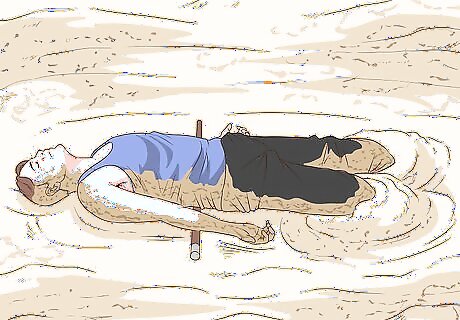
views
Getting Your Feet Out

Drop everything. If you step into quicksand and you're wearing a backpack or carrying something heavy, immediately take off your backpack or drop what you're carrying. Because your body is less dense than quicksand, you can't fully sink unless you panic and struggle too much or you're weighed down by something heavy. If it's possible to get out of your shoes, do so. Shoes, especially those with flat, inflexible soles (many boots, for example) create suction as you try to pull them out of quicksand. If you know ahead of time that you are highly likely to encounter quicksand, change out of your boots and either go barefoot or wear shoes that you can pull your feet out of easily.

Move horizontally. If you feel your feet getting stuck, take a quick couple of steps backward before the quicksand takes hold. It usually takes a minute for the mix to liquify, which means the best method of getting yourself unstuck is to not get stuck in the first place. If your feet do become stuck, avoid taking big lumbering steps to try to get yourself out. Taking a big step forward might unstick one foot, but push your other farther down, making it extremely difficult to completely unstick yourself.

Lay back. Sit down and lean back if your feet are stuck fast. Creating a larger "footprint" should free your feet by removing the pressure they create, allowing them to float. When you feel them start to come free, roll to your side away from the quicksand and free of its grip. You'll get dirty, but its the quickest and safest way to free yourself.

Take your time. If you're stuck in quicksand, frantic movements will only hurt your cause. Whatever you do, do it slowly. Slow movements will prevent you from agitating the quicksand; vibrations caused by rapid movements can turn otherwise relatively firm ground into more quicksand. More importantly, quicksand can react unpredictably to your movements. If you move slowly, you can more easily stop an adverse reaction and, by doing so, avoid getting yourself stuck deeper. You're going to need to be patient. Depending on how much quicksand is around you, it could take several minutes or even hours to slowly, methodically get yourself out.
Getting Out of Deep Quicksand

Relax. Quicksand usually isn't more than a couple feet deep, but if you do happen to come across a particularly deep spot, you could very well sink quite quickly down to your waist or chest. If you panic you can sink further, but if you relax, your body's buoyancy will cause you to float. Breathe deeply. Not only will deep breathing help you remain calm, it will also make you more buoyant. Keep as much air in your lungs as possible. It is impossible to "go under" if your lungs are full of air.

Get on your back and "swim." If you sink up to your hips or higher, bend backward. The more you spread out your weight, the harder it will be to sink. Float on your back while you slowly and carefully extricate your legs. Once your legs are free you can inch yourself to safety by using your arms to slowly and smoothly propel yourself backward with your arms in a sweeping motion, as if you were swimming. When you get near the edge of the quicksand, you can roll to hard ground.

Use a stick. Carry a walking stick any time you're in quicksand country. As soon as you feel your ankles sink, lay the pole on the surface of the quicksand horizontally behind you. Flop onto your back on top of the pole. After a minute or two, you will achieve balance in the quicksand, and you'll stop sinking. Work the pole towards a new position; move it under your hips. The pole will prevent your hips from sinking, so you can slowly pull one leg free, then the other. Stay flat on your back with your arms and legs fully touching the quicksand and use the pole as a guide. Inch sideways along the pole to firm ground.

Take frequent breaks. The work of extracting yourself can be exhausting, so you need to work judiciously, conserving your energy before you become too tired. You do need to move quickly, however, as the pressure of the sand can shut off your blood flow and cause nerve damage, numbing your legs and making it almost impossible to free yourself without help. Contrary to popular movies and television, most quicksand-related fatalities do not occur because you become sucked under, but from exposure or drowning in incoming tides.
Avoiding Quicksand

Recognize common quicksand areas. While quicksand is not a unique kind of soil, it can form anywhere groundwater mixes with sandy soil, creating a distinctive soupy mixture. Learning to anticipate places you might encounter quicksand is the best way to avoid becoming entangled in it. Quicksand most commonly occurs in: Tidal flats Swamps and marshes Near lake shores Near underground springs

Look for ripples. Be on the lookout for ground that appears unstable and wet, or sand that has unnatural looking "ripples" in the texture. You should be able to see water seeping up from below the sand, making quicksand quite visible if you're on the lookout as you're hiking around.

Test the ground in front of you with your walking stick. Always bring a hefty walking stick, both to use in case you become stuck, but also to tap the ground in front of you as you walk. A few seconds with a walking stick could be the difference between a messy wrestling match with a pool of quicksand and a safe hike.













Comments
0 comment